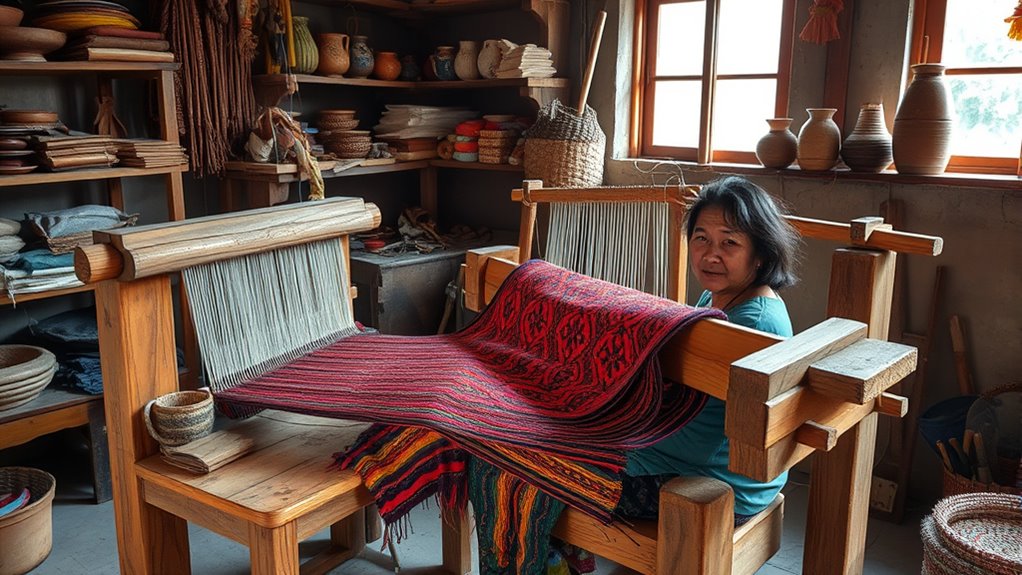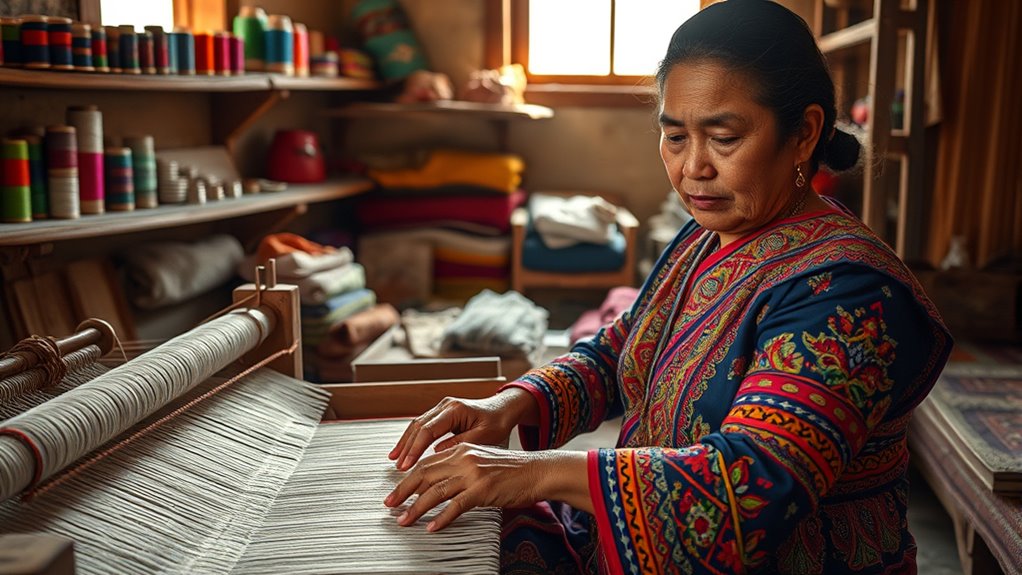Supporting traditional crafts and artisans helps preserve valuable cultural heritage while strengthening local economies. When you buy handmade products, you directly aid artisans, providing them with fair income and sustainable livelihoods. This support keeps centuries-old techniques alive and promotes community development, especially for marginalized groups. By choosing authentic crafts, you also contribute to social inclusion and cultural identity. Discovering more about these efforts can show how your actions make a lasting impact on communities worldwide.
Key Takeaways
- Supporting artisans preserves cultural heritage and traditional techniques vital to community identity.
- Promoting artisanal products boosts local economies and creates sustainable employment opportunities.
- Direct market access and fair trade practices increase artisans’ income and reduce exploitation.
- Craftsmanship fosters social inclusion, empowering marginalized groups like women and indigenous populations.
- Growing demand for handmade, culturally significant products encourages the preservation and innovation of traditional crafts.

Traditional crafts and artisans play an essential role in preserving cultural heritage while boosting local economies. When you support artisanal products, you’re helping maintain centuries-old techniques that might otherwise fade away. These crafts not only reflect the unique identity of a community but also contribute remarkably to economic growth, especially in rural and disadvantaged areas. The artisan sector has a notable global impact, with figures showing that it can generate hundreds of billions of dollars annually, depending on the source. This sector provides crucial employment opportunities, often serving as the second-largest employer in many developing countries. By engaging in artisan work, you contribute to creating sustainable livelihoods that help lift families out of poverty and promote social inclusion.
Supporting artisans preserves cultural heritage and boosts economic growth worldwide.
You might not realize it, but the market for handmade, high-quality products is growing steadily. Tourists and consumers increasingly value products with cultural significance and craftsmanship, willing to pay premium prices for authentic, unique goods. This demand gives artisans a competitive edge, especially in developing countries where traditional skills and local materials are abundant. These crafts are highly marketable because they stand out for their originality and cultural stories. Whether it’s handcrafted textiles, pottery, jewelry, or woodwork, these items often fetch higher markups, allowing artisans to improve their income. Low raw material costs further enhance profit margins, making artisanal crafts a lucrative endeavor if marketed properly. Effective marketing strategies, especially those targeting tourists, can notably increase artisans’ earnings and help sustain their craft.
Supporting traditional crafts also benefits communities on a broader scale. Artisanal work encourages social inclusion by providing opportunities for marginalized groups, including women and indigenous populations. When families pass down skills from generation to generation, it promotes cultural preservation and strengthens community bonds. Artisans are deeply engaged in their local economies, contributing to a vibrant marketplace that stimulates local businesses and attracts tourism. These crafts foster a sense of pride and cultural identity while promoting local engagement in production and sales. As a result, communities become more resilient, with sustainable livelihoods that help reduce poverty. Additionally, investment in craftsmanship can lead to the development of new skills and innovation within traditional sectors, ensuring their relevance in a modern economy. Supporting this sector also helps preserve traditional techniques, which are often at risk of disappearing due to modernization and globalization.
However, artisans face challenges like income instability and limited access to larger markets. Middlemen can cut into profits, and fluctuating demand can threaten their livelihoods. Despite these hurdles, opportunities abound through improved marketing, fair trade practices, and direct access to global markets. By choosing to buy and promote artisanal products, you support a crucial sector that preserves cultural heritage, generates employment, and fosters community development. Your appreciation and purchase of traditional crafts don’t just bring beauty into your life — they help sustain the social and economic fabric of communities around the world.
Frequently Asked Questions
How Do Traditional Crafts Impact Local Economies?
You might wonder how traditional crafts influence local economies. They create jobs and income for artisans and suppliers, boosting local spending and economic growth. Selling crafts attracts tourists, increasing revenue and supporting local businesses. These activities promote sustainable development by using local resources and reducing reliance on external markets. Overall, traditional crafts diversify markets, foster community engagement, and help build a resilient, thriving economy in your area.
What Are the Most Endangered Artisan Skills Today?
Like a fragile butterfly, some artisan skills are on the brink of vanishing. Today, the most endangered crafts include mouth-blown glass making, traditional textiles, and intricate woodworking. These skills face extinction due to economic pressures, societal changes like Brexit, and limited training opportunities. You can help by raising awareness, supporting conservation efforts, and encouraging new artisans to learn and carry on these essential cultural traditions.
How Can Consumers Verify the Authenticity of Handmade Products?
To verify if a handmade product is authentic, you should examine its unique features, like slight imperfections and natural variations, which differ from mass-produced items. Check the quality of materials, packaging, and labels for consistency and accuracy. Research the seller’s reputation, look for detailed descriptions, and ask for proof of authenticity. Using digital tools like QR codes or apps can also help confirm the product’s origins and legitimacy.
What Role Do Government Policies Play in Supporting Artisans?
Government policies play a vital role in supporting artisans by providing financial assistance, training, and market access. They help you invest in better tools, improve your skills, and reach wider audiences through exhibitions and e-commerce. These initiatives also promote sustainable practices and preserve cultural heritage. By fostering infrastructure, collective bargaining, and export incentives, the government empowers you to grow your craft business, ensuring your traditional skills thrive in a competitive market.
How Can Technology Help Preserve Traditional Crafts?
You can use technology to preserve traditional crafts by adopting tools like 3D scanning and digital archiving, which capture and store detailed records of crafts. Virtual reality offers immersive educational experiences, while online platforms expand market reach and encourage community involvement. These innovations help uphold cultural heritage, modernize practices, and guarantee that traditional crafts are accessible and appreciated for generations to come.
Conclusion
By supporting traditional crafts and artisans, you become a essential thread in the vibrant tapestry of local communities. Your appreciation can breathe new life into age-old skills, turning them from fragile whispers of the past into lively songs of the present. When you choose handmade, you’re not just buying a product—you’re planting seeds of hope and resilience. Together, you and these artisans nurture a rich heritage, ensuring it blossoms for generations to come.









